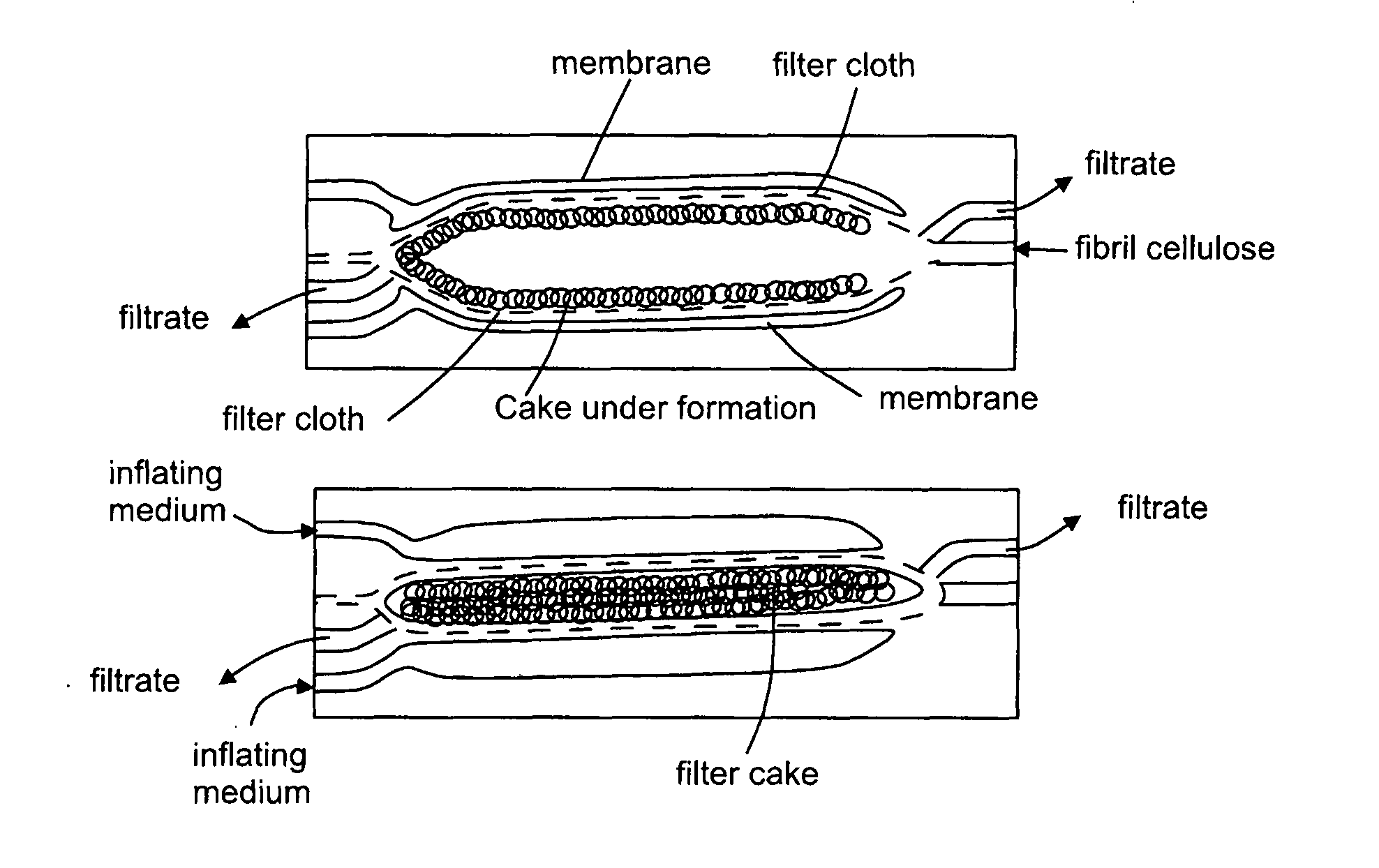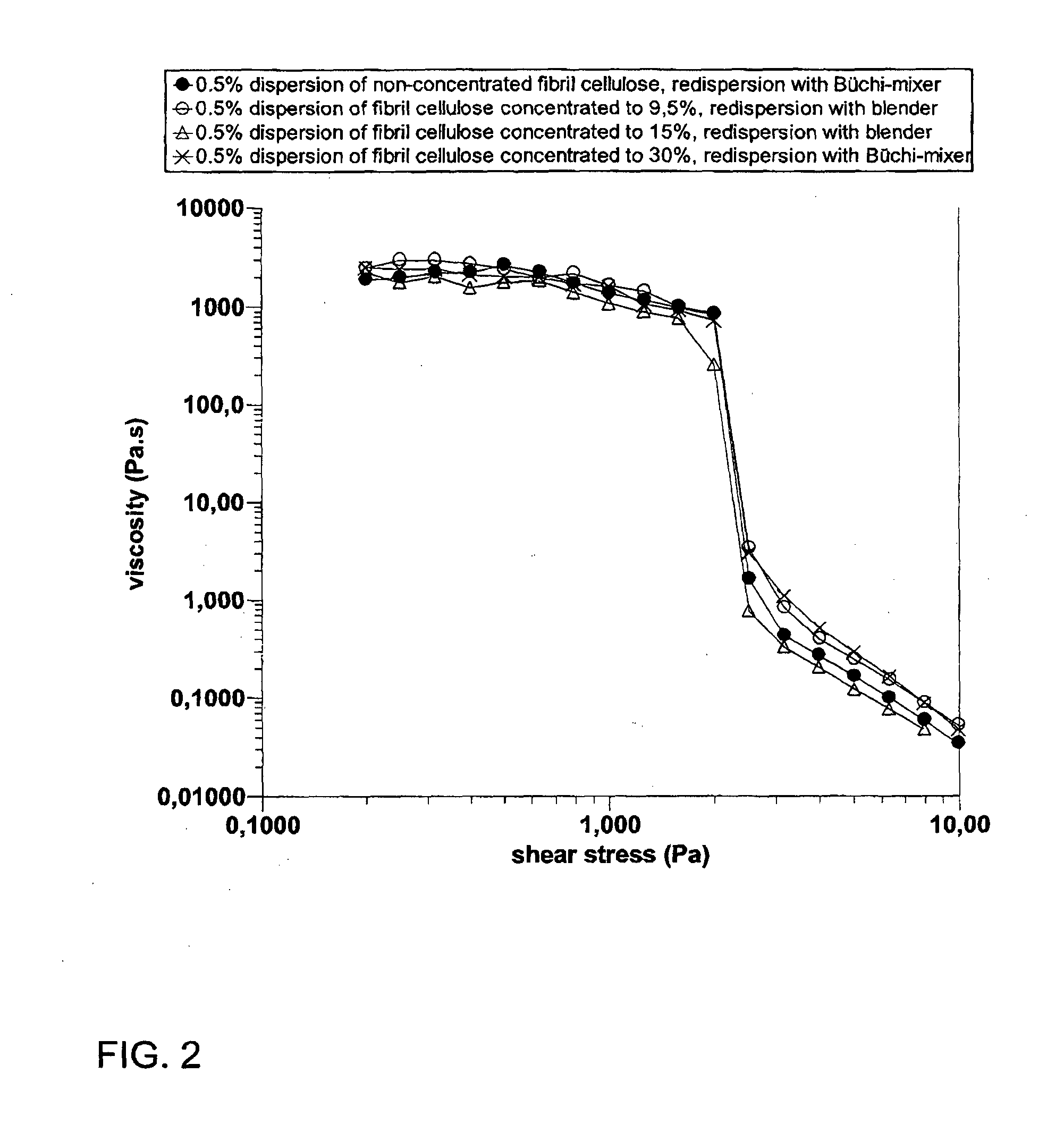Method for concentrating fibril cellulose and fibril cellulose product
a technology of fibril cellulose and cellulose, which is applied in the direction of cellulosic plastic layered products, separation processes, filtration separation, etc., can solve the problems of inability to achieve a dry substance content of more than 10 wt-% by mechanical means, high cost of material transportation from the production site, and inability to meet the economic feasibility of industrial scale, etc., to achieve the effect of increasing the concentration of fibril cellulos
- Summary
- Abstract
- Description
- Claims
- Application Information
AI Technical Summary
Benefits of technology
Problems solved by technology
Method used
Image
Examples
example 1
[0052]Fibril cellulose was concentrated by pressure filtration to a dry matter content of 30%. Fibril cellulose dispersions were prepared at 0.5 and 1.0% concentrations by mixing pieces of filter cake with water in a Büchi-mixer (B400, max. power 2100 W, BÜCHI Labortechnik AG, Switzerland) for three 10 s cycles. Corresponding dispersions were prepared from non-concentrated fibril cellulose having an initial dry matter content of 2%. The viscosity of the dispersions was measured as function of the applied shear stress with a AR-G2 rheometer (TA Instruments, UK) equipped with a vane geometry.
[0053]FIG. 1 presents the results of the viscosity measurements as flow curves of 0.5% and 1% fibril cellulose dispersions prepared from material concentrated to 30% dry matter by pressure filtration and from non-concentrated material. The viscosity of 0.5% and 1.0% fibril cellulose dispersions prepared from the concentrated material was comparable to the viscosity of the dispersions having the sa...
example 2
[0055]Fibril cellulose was concentrated by pressure filtration to various dry matter levels. Dispersions at a concentration of 0.5% were prepared from the non-concentrated fibril cellulose and from the material concentrated to 30% dry matter as described in Example 1 above. From fibril cellulose concentrated to 10 and 15% dry matter, 0.5% dispersions were made in water by mixing with a low-power blender (Mini-Mix, Nordica, power 150 W) for several short cycles within a period of 5 min. The viscosity of the dispersions was measured as described in Example 1.
[0056]FIG. 2 presents flow curves of 0.5% fibril cellulose dispersions prepared from material concentrated to various dry matter levels in comparison with 0.5% dispersions made from the non-concentrated material. Redispersion was performed either with a low-power blender (Mini-Mix) or with the Büchi-mixer.
[0057]The results in FIG. 2 show that fibril cellulose concentrated to 10 and 15% dry matter content can be successfully redisp...
PUM
| Property | Measurement | Unit |
|---|---|---|
| Temperature | aaaaa | aaaaa |
| Temperature | aaaaa | aaaaa |
| Fraction | aaaaa | aaaaa |
Abstract
Description
Claims
Application Information
 Login to View More
Login to View More - R&D
- Intellectual Property
- Life Sciences
- Materials
- Tech Scout
- Unparalleled Data Quality
- Higher Quality Content
- 60% Fewer Hallucinations
Browse by: Latest US Patents, China's latest patents, Technical Efficacy Thesaurus, Application Domain, Technology Topic, Popular Technical Reports.
© 2025 PatSnap. All rights reserved.Legal|Privacy policy|Modern Slavery Act Transparency Statement|Sitemap|About US| Contact US: help@patsnap.com



